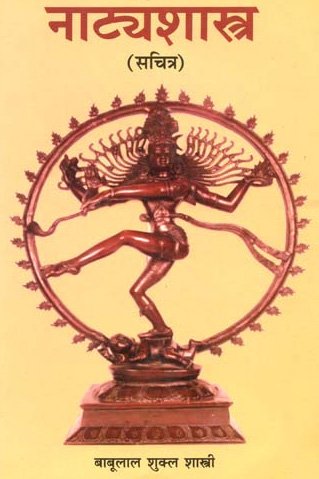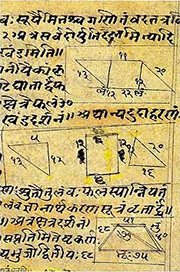Kshiti, Kṣiti: 26 definitions
Introduction:
Kshiti means something in Buddhism, Pali, Hinduism, Sanskrit, Jainism, Prakrit, the history of ancient India, Marathi, Hindi, Tamil. If you want to know the exact meaning, history, etymology or English translation of this term then check out the descriptions on this page. Add your comment or reference to a book if you want to contribute to this summary article.
The Sanskrit term Kṣiti can be transliterated into English as Ksiti or Kshiti, using the IAST transliteration scheme (?).
In Hinduism
Purana and Itihasa (epic history)
Source: archive.org: Shiva Purana - English TranslationKṣiti (क्षिति) refers to the “earth”, according to the Śivapurāṇa 2.3.4.—Accordingly, as the Gods eulogized Umā (Durgā/Satī) with devotion:—“[...] O great Goddess, the purpose of the gods has not been completely carried out. The sages are agitated. Hence we, Gods, have sought refuge in you. O great Goddess, please fulfil the desire of the God, O Śivā, so that the words of Sanatkumāra may be fruitful. O Goddess, incarnating again on the earth [i.e., kṣiti—avatīrya kṣitau] please be the wife of Rudra (Śiva) again. Carry on your sports in a fitting manner and let the Gods be happy. [...]”.
Source: Cologne Digital Sanskrit Dictionaries: The Purana IndexKṣiti (क्षिति).—A secondary divinity.*
- * Bhāgavata-purāṇa IV. 14. 26.

The Purana (पुराण, purāṇas) refers to Sanskrit literature preserving ancient India’s vast cultural history, including historical legends, religious ceremonies, various arts and sciences. The eighteen mahapuranas total over 400,000 shlokas (metrical couplets) and date to at least several centuries BCE.
Natyashastra (theatrics and dramaturgy)
Source: Wisdom Library: SaṅgītaśiromaṇiKṣiti (क्षिति) refers to one of the twenty-two quarters tones (śruti) existing within an octave, according to the Saṅgīta-ratnākara (“ocean of music and dance”). This work is an important Sanskrit treatise dealing with ancient Indian musicology (gāndharva-śāstra), composed by Śārṅgadeva in the 13th century and deals with both Carnatic and Hindustani music. Kṣiti has a frequency of 353.1945Hz.

Natyashastra (नाट्यशास्त्र, nāṭyaśāstra) refers to both the ancient Indian tradition (shastra) of performing arts, (natya—theatrics, drama, dance, music), as well as the name of a Sanskrit work dealing with these subjects. It also teaches the rules for composing Dramatic plays (nataka), construction and performance of Theater, and Poetic works (kavya).
Shilpashastra (iconography)
Source: archive.org: Illustrations of Indian Music and Dance in Western Indian StyleKṣiti (क्षिति, “earth”).—Illustration of Kṣiti-śruti according to 15th century art:—The colour of her body is golden. She holds a vīṇā with both hands. The colour of her bodice is golden and the scarf is sky-blue with a crimson-coloured design; the lower garment is rosy with a crimson-coloured design and borders are of golden colour.
The illustrations (of, for example Kṣiti) are found scattered throughout ancient Jain manuscripts from Gujarat. The descriptions of these illustrations of this citrāvalī are based on the ślokas of Vācanācārya Gaṇi Sudhākalaśa’s Saṅgītopaniṣatsāroddhāra (14th century) and Śārṅgadeva’s Saṅgītaratnākara (13th century).

Shilpashastra (शिल्पशास्त्र, śilpaśāstra) represents the ancient Indian science (shastra) of creative arts (shilpa) such as sculpture, iconography and painting. Closely related to Vastushastra (architecture), they often share the same literature.
Ayurveda (science of life)
Nighantu (Synonyms and Characteristics of Drugs and technical terms)
Source: Wisdom Library: Raj NighantuKṣiti (क्षिति) refers to “earth” and is mentioned in a list of 53 synonyms for dharaṇi (“earth”), according to the second chapter (dharaṇyādi-varga) of the 13th-century Raj Nighantu or Rājanighaṇṭu (an Ayurvedic encyclopedia). The Dharaṇyādi-varga covers the lands, soil [viz., Kṣiti], mountains, jungles and vegetation’s relations between trees and plants and substances, with their various kinds.

Āyurveda (आयुर्वेद, ayurveda) is a branch of Indian science dealing with medicine, herbalism, taxology, anatomy, surgery, alchemy and related topics. Traditional practice of Āyurveda in ancient India dates back to at least the first millenium BC. Literature is commonly written in Sanskrit using various poetic metres.
Kavya (poetry)
Source: Brill: Śaivism and the Tantric Traditions (kavya)Kṣiti (क्षिति) refers to “portents” [?], according to Kālidāsa’s Raghuvaṃśa verse 1.64.—Accordingly: “The king who knew what to do asked his guru about those portents (kṣiti—gurum īśvaraḥ kṣiteḥ) like the headwind etc., if they would be averted soon, and he removed his fears saying, ‘It will end well’”.

Kavya (काव्य, kavya) refers to Sanskrit poetry, a popular ancient Indian tradition of literature. There have been many Sanskrit poets over the ages, hailing from ancient India and beyond. This topic includes mahakavya, or ‘epic poetry’ and natya, or ‘dramatic poetry’.
Ganitashastra (Mathematics and Algebra)
Source: archive.org: Hindu Mathematics1) Kṣiti (क्षिति) represents the number 1 (one) in the “word-numeral system” (bhūtasaṃkhyā), which was used in Sanskrit texts dealing with astronomy, mathematics, metrics, as well as in the dates of inscriptions and manuscripts in ancient Indian literature.—A system of expressing numbers by means of words arranged as in the place-value notation was developed and perfected in India in the early centuries of the Christian era. In this system the numerals [e.g., 1—kṣiti] are expressed by names of things, beings or concepts, which, naturally or in accordance with the teaching of the Śāstras, connote numbers.
2) Kṣiti (क्षिति) refers to a “hundred quintillion” (100,000,000,000,000,000,000) in various lists of numeral denominations, according to gaṇita (“science of calculation”) and Gaṇita-śāstra, ancient Indian mathematics and astronomy.—We can definitely say that from the very earliest known times, ten has formed the basis of numeration in India. While the Greeks had no terminology for denominations above the myriad (104), and the Romans above the milk (103), the ancient Hindus dealt freely with no less than eighteen denominations [e.g., kṣiti]. Cf. Yajurveda-saṃhitā (Vājasanyī) XVII.2; Taittirīya-saṃhitā IV.40.11, VII.2.20.1; Maitrāyaṇī-saṃhitā II.8.14; Kāṭhaka-saṃhitā XVII.10, XXXIX.6; Anuyogadvāra-sūtra 142; Āryabhaṭīya II.2; Triśatikā R.2-3; Gaṇitasārasaṃgraha I.63-68.

Ganitashastra (शिल्पशास्त्र, gaṇitaśāstra) refers to the ancient Indian science of mathematics, algebra, number theory, arithmetic, etc. Closely allied with astronomy, both were commonly taught and studied in universities, even since the 1st millennium BCE. Ganita-shastra also includes ritualistic math-books such as the Shulba-sutras.
Shaivism (Shaiva philosophy)
Source: SOAS University of London: Protective Rites in the Netra TantraKṣiti (क्षिति) refers to the “Earth”, according to the Svacchanda-tantra.—Accordingly, [verse 4.13-16, while describing auspicious dreams]—“After [the dreamer] has seen these [images listed above], he is successful. Likewise, [success comes to those who] obtain the Earth (kṣiti-lābha) and a [battle] wound. Victory in battle and crossing the battle field, which is an ocean of blood and blazes like a place of the departed [are auspicious]. [Someone who] commands heroes and persons who rule [with] victory [are fortunate signs]. [...]”.

Shaiva (शैव, śaiva) or Shaivism (śaivism) represents a tradition of Hinduism worshiping Shiva as the supreme being. Closely related to Shaktism, Shaiva literature includes a range of scriptures, including Tantras, while the root of this tradition may be traced back to the ancient Vedas.
General definition (in Hinduism)
Source: archive.org: Vedic index of Names and SubjectsKṣiti (क्षिति) is in the Rigveda a regular word for ‘dwelling,’ and in particular the kṣitir dhruvā, ‘the secure dwelling,’ is mentioned in a context that shows it to be equivalent to the Vṛjana or Grāma regarded as a stronghold.
In Buddhism
Tibetan Buddhism (Vajrayana or tantric Buddhism)
Source: Wisdom Library: Tibetan BuddhismKṣiti (क्षिति) is the name of a Bodhisattva mentioned as attending the teachings in the 6th century Mañjuśrīmūlakalpa: one of the largest Kriyā Tantras devoted to Mañjuśrī (the Bodhisattva of wisdom) representing an encyclopedia of knowledge primarily concerned with ritualistic elements in Buddhism. The teachings in this text originate from Mañjuśrī and were taught to and by Buddha Śākyamuni in the presence of a large audience (including Kṣiti).

Tibetan Buddhism includes schools such as Nyingma, Kadampa, Kagyu and Gelug. Their primary canon of literature is divided in two broad categories: The Kangyur, which consists of Buddha’s words, and the Tengyur, which includes commentaries from various sources. Esotericism and tantra techniques (vajrayāna) are collected indepently.
In Jainism
General definition (in Jainism)
Source: The University of Sydney: A study of the Twelve ReflectionsKṣiti (क्षिति) refers to the “earth”, according to the 11th century Jñānārṇava, a treatise on Jain Yoga in roughly 2200 Sanskrit verses composed by Śubhacandra.—Accordingly, “The rain clouds, wind, sun, moon, earth, ocean and Indra [com.—meghavāyusūryendukṣitisamudrendrāḥ] —those, which are protected by the doctrine, are of service to the whole world. I think, that doctrine, whose progress is unimpeded, has arisen for the benefit of the world of living souls in the guise of world-protectors”.
Synonyms: Dhāra.

Jainism is an Indian religion of Dharma whose doctrine revolves around harmlessness (ahimsa) towards every living being. The two major branches (Digambara and Svetambara) of Jainism stimulate self-control (or, shramana, ‘self-reliance’) and spiritual development through a path of peace for the soul to progess to the ultimate goal.
India history and geography
Source: Cologne Digital Sanskrit Dictionaries: Indian Epigraphical GlossaryKṣiti.—(IE 7-1-2), ‘one’. Note: kṣiti is defined in the “Indian epigraphical glossary” as it can be found on ancient inscriptions commonly written in Sanskrit, Prakrit or Dravidian languages.

The history of India traces the identification of countries, villages, towns and other regions of India, as well as mythology, zoology, royal dynasties, rulers, tribes, local festivities and traditions and regional languages. Ancient India enjoyed religious freedom and encourages the path of Dharma, a concept common to Buddhism, Hinduism, and Jainism.
Languages of India and abroad
Marathi-English dictionary
Source: DDSA: The Molesworth Marathi and English Dictionarykṣiti (क्षिति).—f S The earth. 2 Waste, decline, decrease, wane. 3 (kṣati q. v. Sig. III.) Care or concern about; i. e. minding or regarding as a loss or a harm. v dhara, bāḷaga. A popular sense.
Source: DDSA: The Aryabhusan school dictionary, Marathi-Englishkṣiti (क्षिति).—f The earth. Care about. Waste.
Marathi is an Indo-European language having over 70 million native speakers people in (predominantly) Maharashtra India. Marathi, like many other Indo-Aryan languages, evolved from early forms of Prakrit, which itself is a subset of Sanskrit, one of the most ancient languages of the world.
Sanskrit dictionary
Source: DDSA: The practical Sanskrit-English dictionaryKṣiti (क्षिति).—f. [kṣi nivāse ādhāre ktin]
1) The earth, soil of the earth; Mahābhārata (Bombay) 4.
2) A dwelling, an abode, a house; तं भक्तिभावोऽभ्यगृणादसत्वरं परिश्रुतोरुश्रवसं ध्रुवक्षितिः (taṃ bhaktibhāvo'bhyagṛṇādasatvaraṃ pariśrutoruśravasaṃ dhruvakṣitiḥ) Bhāgavata 4.9.5.
3) Loss, destruction.
4) The end of the world.
5) Wane.
6) A man (Ved.)
7) Prosperity; क्षिते रोहः प्रवहः शश्वदेव (kṣite rohaḥ pravahaḥ śaśvadeva) Mahābhārata (Bombay) 13.76.1.
8) Number 'one'; Bij.
Derivable forms: kṣitiḥ (क्षितिः).
Source: Cologne Digital Sanskrit Dictionaries: Shabda-Sagara Sanskrit-English DictionaryKṣiti (क्षिति).—f.
(-tiḥ) 1. The earth. 2. An abode, a dwelling, a house. 3. Loss, destruction, wane. 4. The period of the destruction of the universe. 5. A perfume, commonly called Rochana. E. kṣi to waste, to dwell, &c, ktin aff.
Source: Cologne Digital Sanskrit Dictionaries: Benfey Sanskrit-English DictionaryKṣiti (क्षिति).—[kṣi + ti] 1., f. 1. An abode, [Bhāgavata-Purāṇa, (ed. Burnouf.)] 4, 9, 5. 2. The earth, [Bhartṛhari, (ed. Bohlen.)] 3, 5. 3. Land, [Rājataraṅgiṇī] 5, 109.
Source: Cologne Digital Sanskrit Dictionaries: Cappeller Sanskrit-English DictionaryKṣiti (क्षिति).—1. [feminine] abode, settlement, the earth; [plural] the settlements, i.e. tribes, nations, men, people.
--- OR ---
Kṣiti (क्षिति).—2. [feminine] destruction, decay, end.
Source: Cologne Digital Sanskrit Dictionaries: Monier-Williams Sanskrit-English Dictionary1) Kṣiti (क्षिति):—[from kṣi] 1. kṣiti f. dominion (Comm.), [Mahābhārata xiii, 76, 10.]
2) [from kṣi] 2. kṣiti f. an abode, dwelling, habitation, house (cf. also uruand su-kṣiti, dhruva.), [Ṛg-veda]
3) [v.s. ...] ([Naighaṇṭuka, commented on by Yāska i, 1]) the earth, soil of the earth, [Manu-smṛti; Mahābhārata; Rāmāyaṇa] etc.
4) [v.s. ...] the number ‘one’ [Bījagaṇita]
5) [v.s. ...] (ayas) settlements, colonies, races of men, nations (of which five are named; cf. kṛṣṭi), [Ṛg-veda]
6) [v.s. ...] (said of the families of the gods), [ iii, 20, 4]
7) [v.s. ...] estates, [Rājataraṅgiṇī v, 109] (cf. uruand su-kṣiti, dhārayat-, dhruva-, bhava-, raṇa-, samara-.)
8) [from kṣi] 3. kṣiti f. wane, perishing, ruin, destruction, [Atharva-veda]
9) [v.s. ...] the period of the destruction of the universe, end of the world, [cf. Lexicographers, esp. such as amarasiṃha, halāyudha, hemacandra, etc.] (cf. a-, asura-.)
10) [from kṣita > kṣit] a 3.
11) [v.s. ...] b See √1. 2. and 4. kṣi.
12) 4. kṣiti m. Name of a man, [Pravara texts]
13) f. a sort of yellow pigment, [cf. Lexicographers, esp. such as amarasiṃha, halāyudha, hemacandra, etc.]
14) a sort of base metal
15) = kṣiti-kṣama (sub voce 2. kṣiti), [Demetrius Galanos’s Lexiko: sanskritikes, anglikes, hellenikes]
Source: Cologne Digital Sanskrit Dictionaries: Yates Sanskrit-English DictionaryKṣiti (क्षिति):—(tiḥ) 2. f. The earth, an abode; loss; a perfume.
Source: DDSA: Paia-sadda-mahannavo; a comprehensive Prakrit Hindi dictionary (S)Kṣiti (क्षिति) in the Sanskrit language is related to the Prakrit word: Khii.
[Sanskrit to German]
Sanskrit, also spelled संस्कृतम् (saṃskṛtam), is an ancient language of India commonly seen as the grandmother of the Indo-European language family (even English!). Closely allied with Prakrit and Pali, Sanskrit is more exhaustive in both grammar and terms and has the most extensive collection of literature in the world, greatly surpassing its sister-languages Greek and Latin.
Hindi dictionary
Source: DDSA: A practical Hindi-English dictionaryKṣiti (क्षिति):—(nf) the earth; land.
...
Kannada-English dictionary
Source: Alar: Kannada-English corpusKṣiti (ಕ್ಷಿತಿ):—
1) [noun] the earth.
2) [noun] an area; a place; a space; a region.
3) [noun] a piece of cleared land, set off or enclosed, for raising crops or pasturing livestock; a field.
4) [noun] a declining or decaying; deterioration.
5) [noun] a building where one normally lives; a residence; a house.
6) [noun] (math.) a number (having twenty zeros following 'one').
--- OR ---
Kṣitipāla (ಕ್ಷಿತಿಪಾಲ):—[noun] a ruler; a king.
--- OR ---
Kṣitipālaka (ಕ್ಷಿತಿಪಾಲಕ):—[noun] = ಕ್ಷಿತಿಪಾಲ [kshitipala].
--- OR ---
Kṣitipālamara (ಕ್ಷಿತಿಪಾಲಮರ):—[noun] the tree Ziziphus glabrata ( = Z. trinerva) of Rhamnaceae family; jagged jujube tree.
--- OR ---
Kṣitirakṣaka (ಕ್ಷಿತಿರಕ್ಷಕ):—[noun] = ಕ್ಷಿತಿಪಾಲ [kshitipala].
--- OR ---
Kṣitiramaṇa (ಕ್ಷಿತಿರಮಣ):—[noun] = ಕ್ಷಿತಿಪಾಲ [kshitipala].
--- OR ---
Kṣitirasa (ಕ್ಷಿತಿರಸ):—[noun] water (either in the ocean or underground).
--- OR ---
Kṣitiruha (ಕ್ಷಿತಿರುಹ):—[noun] a tree that is born on the earth.
--- OR ---
Kṣitivara (ಕ್ಷಿತಿವರ):—[noun] = ಕ್ಷಿತಿಪಾಲ [kshitipala].
--- OR ---
Kṣitivalaya (ಕ್ಷಿತಿವಲಯ):—[noun] the entire earth.
--- OR ---
Kṣitisute (ಕ್ಷಿತಿಸುತೆ):—[noun] = ಕ್ಷಿತಿಜೆ [kshitije].
--- OR ---
Kṣitisura (ಕ್ಷಿತಿಸುರ):—[noun] a man belonging to brāhmaṇa caste; a brāhmaṇa.
--- OR ---
Kṣitīśa (ಕ್ಷಿತೀಶ):—[noun] = ಕ್ಷಿತಿಪಾಲ [kshitipala].
Kannada is a Dravidian language (as opposed to the Indo-European language family) mainly spoken in the southwestern region of India.
Tamil dictionary
Source: DDSA: University of Madras: Tamil LexiconKṣiti (க்ஷிதி) noun < kṣiti.
1. Earth; பூமி. [pumi.]
2. One hundred trillions; ஒரு பேரெண். [oru peren.] (தத்துவநிசானுபோக சாரம் [thathuvanisanupoga saram] 25.)
3. (Music) A division of the fifth note of the gamut; பஞ்சமசுருதியுள் ஒருவகை. [panchamasuruthiyul oruvagai.] (பரதசாஸ்திரம் இராக. [magaparatham iraga.] 44.)
Tamil is an ancient language of India from the Dravidian family spoken by roughly 250 million people mainly in southern India and Sri Lanka.
See also (Relevant definitions)
Starts with (+80): Kshiti-dana, Kshitibadari, Kshitibhartar, Kshitibhartri, Kshitibhrit, Kshitibhritpriya, Kshitibhritta, Kshitibhu, Kshitibhuj, Kshitibhushana, Kshiticakra, Kshiticalana, Kshiticchaya, Kshitichchhaya, Kshitideva, Kshitidevata, Kshitidhara, Kshitidharaguru, Kshitidharemdra, Kshitidharin.
Ends with (+3): Adhikshiti, Akshiti, Apakshiti, Apikshiti, Asurakshiti, Bhavakshiti, Dharayatkshiti, Dhruvakshiti, Ikshubhakshiti, Kamadughakshiti, Krishnakshiti, Mahakshiti, Parikshiti, Ranakshiti, Rauhakshiti, Rohakshiti, Samarakshiti, Sukshiti, Tarakshiti, Tirikshiti.
Full-text (+136): Kshitipati, Kshitikshit, Kshitiruha, Kshitikshama, Kshitijantu, Kshitikana, Kshitidhara, Kshitipala, Kshitikampa, Kshitimandala, Kshitikhanda, Kshitidharin, Kshitinaga, Kshitija, Kshitidevata, Kshitibhrit, Kshitivardhana, Kshitiputra, Kshitibhuj, Kshitipa.
Relevant text
Search found 36 books and stories containing Kshiti, Kṣiti, Ksiti, Kshithi, Kshidi, Kshidhi; (plurals include: Kshitis, Kṣitis, Ksitis, Kshithis, Kshidis, Kshidhis). You can also click to the full overview containing English textual excerpts. Below are direct links for the most relevant articles:
Sanskrit sources of Kerala history (by Suma Parappattoli)
5.2. Kerala-kshiti-ratnamala < [Chapter 2 - Historical details from Mahatmyas and Prashastis]
Brihad Bhagavatamrita (commentary) (by Śrī Śrīmad Bhaktivedānta Nārāyana Gosvāmī Mahārāja)
Verse 2.2.234 < [Chapter 2 - Jñāna (knowledge)]
Vivekachudamani (by Shankara)
Rig Veda (translation and commentary) (by H. H. Wilson)
Garga Samhita (English) (by Danavir Goswami)
Verses 6.10.18-19 < [Chapter 10 - In the Description of the Gomatī River, the Glories of Cakra-tīrtha]
Bhakti-rasamrta-sindhu (by Śrīla Rūpa Gosvāmī)
Verse 4.3.38 < [Part 3 - Chivalry (vīrya-rasa)]
Verse 2.1.227 < [Part 1 - Ecstatic Excitants (vibhāva)]
Verse 2.3.34 < [Part 3 - Involuntary Ecstatic Expressions (sattvika-bhāva)]